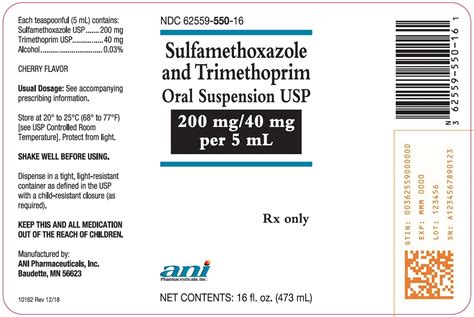Intro
Discover key facts about Sulfamethoxazole Trimethoprim, a potent antibiotic combo, including its uses, side effects, and interactions, to understand this prescription medications role in treating bacterial infections.
Sulfamethoxazole trimethoprim, commonly known as Bactrim, Septra, or Cotrim, is a combination antibiotic used to treat various bacterial infections. This medication has been widely prescribed for decades due to its effectiveness against a broad spectrum of bacteria. Understanding the key aspects of sulfamethoxazole trimethoprim is crucial for patients, healthcare professionals, and anyone interested in antibiotics and their role in modern medicine.
The importance of sulfamethoxazole trimethoprim lies in its ability to combat bacterial infections that could otherwise lead to severe health complications. With the rise of antibiotic resistance, medications like sulfamethoxazole trimethoprim are under scrutiny for their efficacy and safety profiles. It's essential to delve into the specifics of how this drug works, its benefits, potential side effects, and the conditions it treats to appreciate its value in the medical arsenal against bacterial infections.
Sulfamethoxazole trimethoprim has been a staple in the treatment of urinary tract infections (UTIs), among other conditions. Its mechanism of action, involving the inhibition of folic acid synthesis in bacteria, makes it particularly effective against susceptible strains. However, the emergence of resistant bacteria has necessitated a careful approach to its prescription, emphasizing the need for antibiotic stewardship. As we explore the realm of sulfamethoxazole trimethoprim, it becomes clear that understanding its applications, limitations, and potential risks is vital for maximizing its therapeutic benefits while minimizing its contribution to the growing problem of antibiotic resistance.
Introduction to Sulfamethoxazole Trimethoprim

How Sulfamethoxazole Trimethoprim Works
The working mechanism of sulfamethoxazole trimethoprim involves the sequential blockade of the folate synthesis pathway in bacteria. Sulfamethoxazole competes with para-aminobenzoic acid (PABA) for the enzyme dihydropteroate synthetase, which is necessary for the conversion of PABA to dihydropteroic acid, an early step in the synthesis of folic acid. Trimethoprim, on the other hand, inhibits dihydrofolate reductase, the enzyme responsible for converting dihydrofolic acid to tetrahydrofolic acid, the active form of folate. By blocking these two steps, sulfamethoxazole trimethoprim effectively starves the bacteria of the tetrahydrofolate necessary for DNA synthesis and cell division, leading to the inhibition of bacterial growth.Benefits and Uses of Sulfamethoxazole Trimethoprim

Conditions Treated by Sulfamethoxazole Trimethoprim
Some of the specific conditions treated with sulfamethoxazole trimethoprim include: - Urinary tract infections (UTIs): This includes infections of the kidneys (pyelonephritis) and the bladder (cystitis). - Acute exacerbations of chronic bronchitis: Sulfamethoxazole trimethoprim can help manage the bacterial component of these exacerbations. - Traveler's diarrhea: Caused by enterotoxigenic Escherichia coli and other bacteria, sulfamethoxazole trimethoprim can be effective in treating this condition. - Pneumocystis jirovecii pneumonia (PCP): Sulfamethoxazole trimethoprim is a first-line treatment for PCP, particularly in patients with HIV/AIDS.Side Effects and Precautions

Contraindications and Warnings
Sulfamethoxazole trimethoprim is contraindicated in patients with a known hypersensitivity to sulfonamides or trimethoprim, as well as in those with severe renal impairment. Caution is advised when prescribing this medication to patients with liver disease, glucose-6-phosphate dehydrogenase (G6PD) deficiency, or those taking certain other medications that may interact with sulfamethoxazole trimethoprim. Pregnant women, especially those in the late stages of pregnancy, and breastfeeding mothers should use sulfamethoxazole trimethoprim only under the guidance of a healthcare provider due to potential risks to the fetus or newborn.Resistance and Stewardship

Strategies for Reducing Resistance
Strategies to reduce antibiotic resistance include: - Improving antibiotic prescribing practices to ensure that antibiotics are used only when necessary. - Enhancing infection control practices to prevent the spread of infections. - Developing and using diagnostic tests to rapidly identify the causative pathogens and their antibiotic susceptibility patterns. - Promoting the development of new antibiotics and alternative treatments.Conclusion and Future Directions

What is sulfamethoxazole trimethoprim used for?
+Sulfamethoxazole trimethoprim is used to treat various bacterial infections, including urinary tract infections, acute exacerbations of chronic bronchitis, and certain types of diarrhea.
How does sulfamethoxazole trimethoprim work?
+Sulfamethoxazole trimethoprim works by inhibiting the synthesis of tetrahydrofolic acid in bacteria, which is necessary for DNA synthesis and cell division.
What are the common side effects of sulfamethoxazole trimethoprim?
+Common side effects include gastrointestinal disturbances, rash, and increased sensitivity to the sun. Severe side effects can include severe allergic reactions, bone marrow suppression, and liver damage.
We hope this comprehensive overview of sulfamethoxazole trimethoprim has provided valuable insights into its uses, mechanisms, benefits, and limitations. As the medical community continues to navigate the challenges of antibiotic resistance, it's essential for all stakeholders to be informed and engaged in responsible antibiotic use. If you have any further questions or would like to share your experiences with sulfamethoxazole trimethoprim, please don't hesitate to comment below. Your input contributes to a broader understanding and discussion of this critical topic in healthcare.
